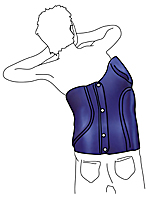If you have scoliosis and are still growing, a brace can help halt the progression of your spinal curve.
If you have scoliosis with a spinal curve of about 25 to 40 degrees and are still growing, your provider may recommend that you wear a brace. The purpose of wearing the brace is to keep the curve in your spine from getting worse as you continue to grow; however, it’s usually not intended to reduce the amount of curve you already have.
What Is A Brace?
There are several different kinds of braces commonly prescribed for children and adolescents with scoliosis. Each is typically constructed of plastic and contoured specifically to your body, with strategically placed padding and straps that place resistance as needed on your particular spinal curve(s).
 Boston Brace |
 Milwaukee Brace |
 Charleston Brace |
Why Do I Need To Wear A Brace?
The goal of bracing is to keep your curve from progressing. If the curve in your spine is more than 25 degrees and you still have a lot of growing to do, your scoliosis curvature could rapidly get worse.
Whether bracing actually works is controversial. Some clinical studies support the use of bracing in young patients whose curves are at risk of progressing. According to several studies conducted by the Scoliosis Research Society (SRS), bracing successfully stops curve progression in 74% to 93% of female patients with idiopathic scoliosis, depending on the type of brace used and the duration of use(1).
Because bracing is designed to halt the progression of the curve, it’s generally not recommended for treating scoliosis in young people who are skeletally mature or almost mature. Once skeletal growth has reached a certain point, or if the curve has become too severe (typically more than 40-50 degrees), bracing is generally not as effective. Bracing also is typically not recommended for treating adult scoliosis. Corrective surgery (spinal fusion with instrumentation) may be recommended in these instances.
Your provider will determine if bracing is the appropriate treatment for your spinal curve. If so, he or she also will decide which type of brace is appropriate and the length of time the brace should be worn. You and your parents should discuss your treatment and bracing options thoroughly with your provider.
My Providers Says I Need A Brace. What Happens Now?
First, you’ll have a brace fitting with an orthotist, the person or team who will design and make your brace, based on your provider’s prescription. Different parts of your body will be measured so the brace will fit you perfectly.
Once your brace is finished, your orthotist will show you how to put it on properly and give you specific instructions for wearing it. You’ll typically start out wearing your brace for a few hours a day, eventually building up to the full amount of time your provider prescribes, which may be up to 23 hours per day. At first, you may need help putting your brace on, but most patients soon learn how to do this by themselves.
Follow-up visits with your provider, which may include spinal x-rays, will determine whether your brace is keeping your spine positioned correctly. Your brace also will be checked periodically to make sure it’s still fitting properly as you continue to grow. Be sure to ask your provider whom to contact if you have any concerns or difficulties with your brace between checkups.
Is There Anything I Can I Do To Maximize The Benefits Of My Brace?
To give your brace the greatest chance of successfully stopping the progression of your spinal curve, it’s important that you:
- Wear your brace each day for the full amount of time your provider prescribes
- Take good care of your skin daily
- Wear a well-fitting, wrinkle-free undershirt or undershirt/bra combination under your brace at all times
- Put on the brace exactly as instructed by your provider
- Perform any daily exercises recommended by your provider
What Will I Be Able To Do While I’m Wearing My Brace?
Staying active is important and healthy! You should be able to continue to do anything you normally like to do, such as sports, playing an instrument or hanging out with your friends. Your brace may be removed while participating in your sports activity. Any activity you can do while wearing your brace should be okay, but if in doubt, check with your provider first.
What Kind Of Clothes Can I Wear?
You’ll wear your brace under your clothes, so anything that fits over your brace should be fine. Most people find loose-fitting clothes to be more comfortable over the brace, so you may want to consider wearing a size or two larger than usual.
You also should always wear a well-fitted, wrinkle-free, seamless 100% cotton undershirt or t-shirt under your brace. This will help keep the brace from rubbing your skin. Seams can be particularly irritating, so if you can’t find seamless shirts in your local retail stores, contact your orthotic specialist; many custom-make these garments, as well.
- Nachemson AL, Peterson LE. Effectiveness of treatment with a brace in girls who have adolescent idiopathic scoliosis. A prospective, controlled study based on data from the Brace Study of the Scoliosis Research Society. J Bone Joint Surg Am. June 1995;77(6):815-822

